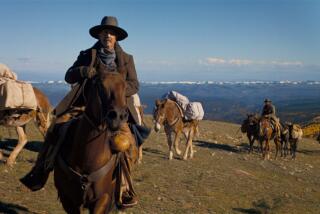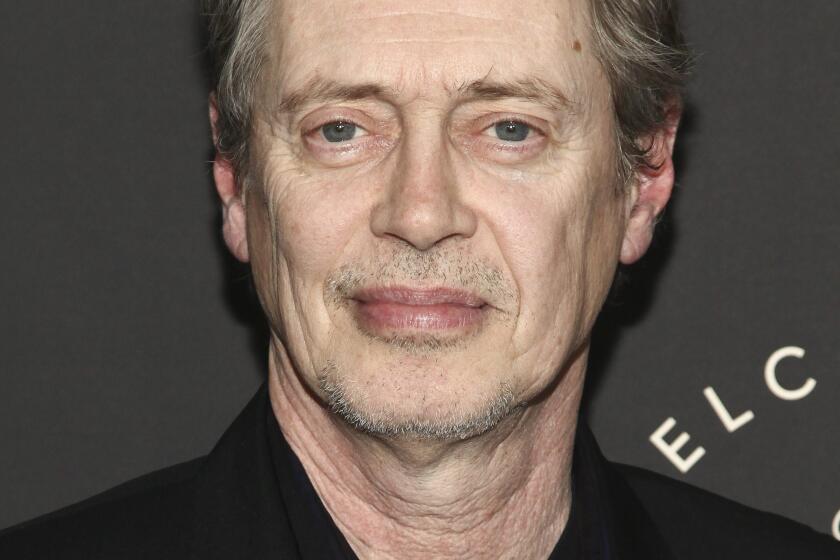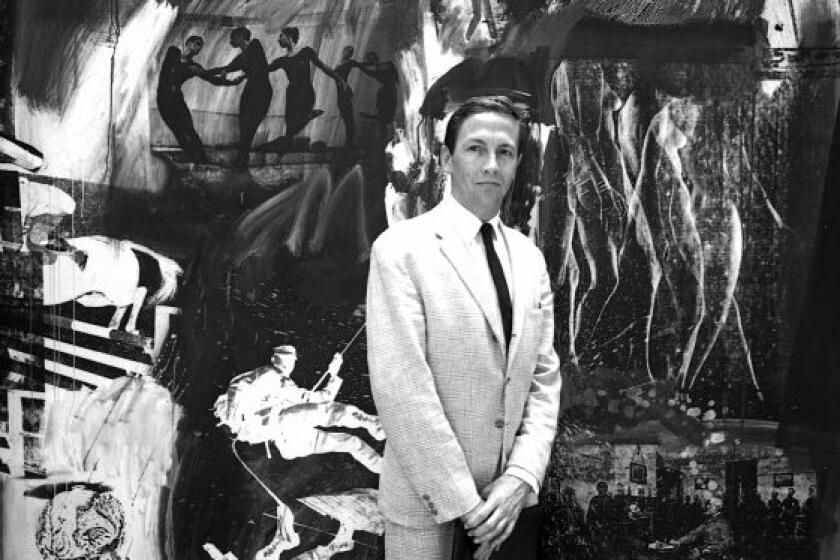This One’s Rated BC
A forbidding handwritten sign, hung on a sound stage door, conveys a chilling warning: “No Entry--Blood on Set.”
Gaining access to the stage by means of another door, one surveys a picture of carnage. Bodies lie slumped on the floor, pools of fake blood forming beside their heads. One man lies crumpled at the foot of a pillar, with a dagger protruding from his chest; for the scene about to be shot, the lead actor is required to dart over to him, place his foot upon the unfortunate man’s shoulder and yank out the dagger.
“Blood!” yells the director. “I need more blood!”
When the camera proceeds along a track for a first take, he calls a halt. “We need this fast, fast, fast,” he tells colleagues. “As quick as we can move the camera.”
Sounds terribly modern, doesn’t it? Fast-moving camera work, graphic violence, a wry, jokey quality to all the bloodletting--it could be a film about contemporary hoodlums by some Tarantino wannabe.
In fact, the story being filmed at Shepperton Studios is 2,800 years old. The scene is from “The Odyssey” by the ancient Greek poet Homer, who probably wrote the epic (along with “The Iliad”) between 800 and 700 BC.
And now--improbably--”The Odyssey” is being filmed as a four-hour TV miniseries, to be broadcast by NBC during the May ratings sweeps this year. Just how improbable is it? Consider this: At a budget closing in on $40 million, it is the most expensive project, on a per-hour basis, ever made for television.
So it’s Armand Assante as the hero Odysseus, dressed not in a gangster’s black suit but in a thigh-length tunic and sandals, who is disengaging the dagger from an extra’s breast. And the man baying for more blood on the gore-strewn floor of the set is Andrei Konchalovsky, the distinguished Russian film director.
This scene is one of only a handful that contains blood, and it looks more violent in real life (and sounds it when described in words) than it will on TV screens; “The Odyssey,” conceived as a family show, will stay within the guidelines about violence set by the network.
The prime mover, so to speak, of this extraordinary production is Robert Halmi Sr., the flamboyant, Hungarian-born producer and chairman of Hallmark Entertainment who was responsible last year for turning “Gulliver’s Travels,” another adaptation of a classic literary work, into unlikely ratings gold for NBC.
“Networks think in terms of demographics,” Halmi said. “They don’t look at the American public as a marketplace for anything special like this. ‘Gulliver’s Travels’ opened their eyes a bit. All of a sudden, it had the best ratings of last year.”
He chuckled. “Now they’re afraid to say no to me. So I offered them ‘The Odyssey,’ and they said, ‘Sure, let’s try it.’ And why not? This is a hell of a story. There’s a reason it’s been around thousands of years.”
*
Halmi was determined to execute “The Odyssey” on the scale first conceived by Homer. He insisted on shooting exterior scenes in the region of the epic poem’s action. And he hired three chartered jets to shuttle cast and crew between an isthmus in southern Turkey and the Mediterranean island of Malta, before bringing them back to England for seven weeks of interior shooting.
Production designer Roger Hall was asked to build a 60-foot-high Trojan horse, weighing in at 7 tons and big enough to accommodate 50 Greek soldiers in its innards. Hall, who fulfilled the same role for Halmi on “Gulliver’s Travels,” also designed two 60-foot-long boats, fully operational, to be powered on screen by Odysseus’ oarsmen; they were built in Cornwall, England, and shipped across Europe.
The production commandeered five sound stages at Shepperton Studios outside London. In one of them, Hall created Odysseus’ palace, a remarkable maze of small rooms and cells built around a central courtyard.
He hired a genuinely international cast: Assante as Odysseus, king of Ithaca and hero of the Trojan wars, condemned by the gods for his arrogance to wander the seas for eternity, never to return home; Greta Scacchi plays his pragmatic wife, Penelope, who keeps suitors at bay in her husband’s absence; Geraldine Chaplin is her loyal maid; veteran Greek actress Irene Papas is Odysseus’ mother, Anticlea; Isabella Rossellini is the goddess Athena (who often appears to Odysseus to offer advice); and Bernadette Peters plays the scheming witch Circe. In addition, Eric Roberts portrays one of Penelope’s suitors, and Vanessa Williams plays Calypso, a ravishing sea nymph whom Odysseus meets on his travels.
In keeping with his lofty ambitions, Halmi sought out Konchalovsky, who made classic films such as “Siberiade” in his own country in the 1970s and directed well-received American movies like “Runaway Train” (1985) and “The Inner Circle” (1991) after relocating to the West.
If they ever had any doubts about any scenes, Halmi and Konchalovsky decided to play them big. On a beach near Olympos in Turkey, 800 extras were used for a scene of the funeral of Achilles and the torching of his pyre. Five cameras were used for the scene, one of them operated by Halmi himself.
A 14-minute show reel of “The Odyssey” includes a speech by Assante during which Konchalovsky’s camera sweeps 360 degrees, taking in some breathtaking Mediterranean scenery. In another scene we see Achilles (played by newcomer Richard Trewett) driving a chariot at high speed, dragging a prostrate body behind it. As the camera pans, we see that Achilles is on a cliff-side road, and that this is a shot from a helicopter, which finally affords a panorama of coastline that makes one’s jaw sag.
*
Konchalovsky was first approached about “The Odyssey” two years ago by the project’s then-producer, Francis Ford Coppola, who showed him a script he had commissioned by Nicholas Meyer.
“I told him I wasn’t interested in making television,” Konchalovsky recalled. “I like wide shots, and I like to do a lot of thinking before shooting. Cinema allows you to do that. In TV, you have to film 2 1/2 pages every day.”
A year later he received a call from Halmi (a longtime fan of “Runaway Train”), who was then in London overseeing the shooting of “Gulliver’s Travels.”
“He asked me over to discuss ‘The Odyssey’ with him,” said Konchalovsky, “and when I met Robert I fell in love with his passion, his audacity, even his craziness.
“Then Francis persuaded me to do it. I was worried about heavy network pressure, and he said, ‘No, you can be at the helm, no one [at NBC] will interfere. It’s an artistic project.’ ”
The Russian was also feeling bruised by Hollywood, after “The Inner Circle” (known abroad as “The Projectionist”) was buried on release by Columbia Pictures, which simultaneously opened big movies like “The Prince of Tides,” “Bugsy” and “Hook.”
“I felt like a fiddler playing on a street corner as tanks roared past,” Konchalovsky said. “No one could hear me. [Columbia studio boss] Frank Price told me the film was a masterpiece, but by the time it opened the management had changed and he was gone. The new people didn’t feel as strongly about the film.”
But as a condition of undertaking “The Odyssey,” Konchalovsky, working from Robert Fitzgerald’s 1961 translation, insisted on rewriting Meyer’s script extensively: “It wasn’t tailored for me. It was complete and in the best storytelling traditions, but there was so much story, it left no room for emotions. I knew I had to make changes.” (The Writers Guild of America will adjudicate the screen credits before the program airs.)
But which version actually comes closer to Homer’s original work?
“None is close enough,” Konchalovsky said. “It’s impossible. One tries to get as close as one can to the spirit, to the music of the story. It’s not so much words, it’s the color of the piece.”
Relaxing in his trailer between scenes, Assante agreed: “My biggest frustration is that there will never be a [script] writer who will satisfy me in regard to what Homer should be. It’s an epic poem, and it’s difficult to find buoyancy and humor in what’s basically a lyric narrative. To turn it into human behavior is hard. I knew of it as a kid but didn’t read it. It’s a laborious read. Just as a narrative, it’s not very exciting. So I’ve had to put my faith in Andrei. It becomes a filmmaker’s film.”
Konchalovsky recalled being compelled to read “The Odyssey” as a 17-year-old student in Russia: “I was bored to death by it. Back then I just wanted to play soccer and go with girls. This work was too long, it rhymed, you read it and forgot about it.”
Halmi harbors similar feelings: “A lot of people say they read it in school, but they’re lying. Nobody read the damned thing in school. It’s a title everyone recognizes but no one has read.”
So, given that “The Odyssey” has a daunting reputation, why would millions of people choose to watch it on TV?
“The trick is to do it the way the BBC or PBS might do it,” said Halmi, “combined with what commercial television needs. That is, to take something historic and huge and make entertainment of it.
“I asked Andrei, ‘How will you adapt the story, especially those parts which involve the gods?’ And he said the gods should be contemporary, funny, have a sense of humor.”
Indeed. The show reel also includes a scene between Assante and Rossellini as Athena, whom she plays almost flirtatiously, with tongue-in-cheek humor. Another scene, in which Williams as the beautiful Calypso welcomes Odysseus to her island, noting vampishly that she has not seen a man in 100 years, verges on high camp.
Konchalovsky too is optimistic that the work can be made accessible to a mass audience. He views “The Odyssey” as an archetypal story: “It’s a thriller, it has elements of love, betrayal, revenge--and even a happy ending,” he said. “It’s like a journey from the womb to the grave. It’s a story with universal appeal.” As for the flamboyant manner in which he has been encouraged to shoot it, the directed noted: “It feels like a return to the big screen--even though it’s really not.”
*
There has been one notable previous attempt to commit “The Odyssey” to celluloid: the 1955 Italian production “Ulysses,” starring Kirk Douglas and Anthony Quinn. “I’ve seen it, and it was kind of whimsical, though quite clever and visual,” Assante said. But that seven screenwriters (including Ben Hecht and Irwin Shaw) are credited suggests the difficulties in adapting Homer for the screen.
Yet Halmi is not a man to be intimidated by such matters.
“I do literature on TV and people want to see it,” he said bullishly, agreeing that he is bucking the apparent “dumbing-down” trend in American television. “People were hungry to see ‘Gulliver,’ and they’ll be hungry to see this--maybe because there’s so much junk on TV. After this, they can go back to the junk the next day.”
He firmly believes the networks underestimate Americans’ taste.
“Yes, 100%,” he said. “ ‘Hallmark Hall of Fame’ gets bigger ratings with esoteric movies than anyone else. I had this script ready last February, and NBC said, ‘Wait and see how “Gulliver” performs first.’ Now they want three more years of this kind of stuff from me.”
But Halmi can call the shots; no TV network could afford to commission a $40-million miniseries without a partner, and Halmi’s Hallmark Entertainment is effectively that partner.
“It’s like a studio,” he said of the company. “It has its own distribution, a video [arm], a music and publishing company. We take full advantage of a product. We can pay for it, then wait to sell it. You have to have deep pockets, sure, but it pays off.”
He said that “Gulliver’s Travels,” with a budget well in excess of $20 million, had turned a profit. “Almost every country in the world that has a TV broadcast system bought it,” Halmi added.
Still, “The Odyssey” feels like twice the gamble “Gulliver’s Travels” ever was--the subject matter is that much more historically remote, and “Gulliver” had the advantage that its lead character was played by a bona fide TV star, in America, at least, in Ted Danson.
Yet Assante, who has a tough act to follow, is optimistic too.
“ ‘The Odyssey’ is one of the richest psychological and philosophical treatises ever written,” he said. “It was like the Bible of its time. Will it strike a chord with people? I think it will. Because at its core, it’s about lost family values and people trying to hold on to them. This was primitive man saying, ‘We must hold on to something.’ Today’s audience can relate to that.”
More to Read
Only good movies
Get the Indie Focus newsletter, Mark Olsen's weekly guide to the world of cinema.
You may occasionally receive promotional content from the Los Angeles Times.






